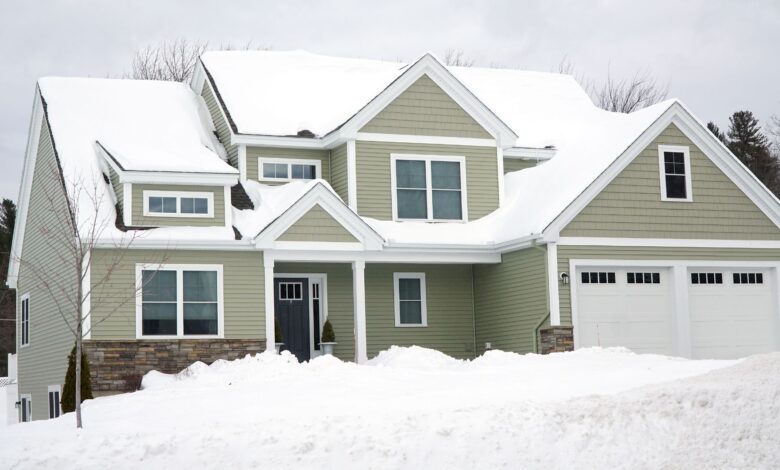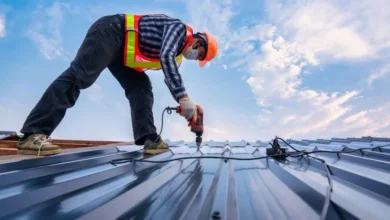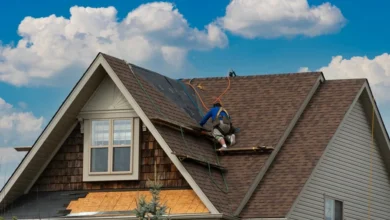Winter Roofing Tips: Preventing Ice Dams and Cold-Weather Damage

Winter transforms rooftops into snow-covered landscapes—but beneath the surface, harsh conditions can quietly wreak havoc. As snow piles up and temperatures dip below freezing, your roof becomes the first line of defense against ice, water, and wind. And without proper preparation, that defense can fail.
Ice dams, flashing failures, and snow buildup aren’t just inconvenient—they can lead to serious, expensive problems that go far beyond the surface. Fortunately, many of these issues can be prevented with smart planning and timely maintenance.
Here’s how to protect your roof throughout the winter months—and avoid the kinds of cold-weather damage that lead to unexpected roof repair or even premature roof replacement.
Problem: Ice Dams Forming at the Roof’s Edge
The Issue:
When warm air from your attic melts snow on your roof, that water runs toward the edge—where it re-freezes. This creates a dam of ice that blocks future melting snow from draining off the roof. Eventually, the water backs up under the shingles and seeps into your home.
The Solution:
- Improve attic insulation to keep heat from escaping through the roof
- Ensure your attic is properly ventilated so cold air circulates evenly
- Clear gutters and downspouts in the fall to maintain smooth drainage
- Use a roof rake to remove snow buildup 3–4 feet above the eaves after major storms
If ice dams are recurring, a roofing company can evaluate whether your ventilation or underlayment needs an upgrade. In some cases, self-regulating heat cables installed along eaves can provide added prevention.
Problem: Snow Load Stress
The Issue:
Snow may look light and fluffy, but over time it compacts—and becomes heavy. A deep snow load puts significant pressure on your roof’s structural components, especially on older homes or roofs with shallow pitches.
The Solution:
- Know your roof’s snow load capacity (varies by region and building type)
- Use a roof rake regularly to remove excess snow, especially after heavy accumulation
- Watch for signs of stress: sagging rafters, creaking sounds, or ceiling cracks
- Avoid climbing onto the roof—removal should be done from the ground or by professionals
Local roofers, including teams like D&G Exteriors, understand regional snow load expectations and can assess whether structural reinforcement or a pre-season roof repair is necessary.
Problem: Flashing Failure and Freeze-Thaw Damage
The Issue:
Roof flashing—metal strips around chimneys, vents, and valleys—seals out moisture at vulnerable points. Winter’s freeze-thaw cycles cause materials to expand and contract, which can loosen or warp flashing, opening the door to leaks.
The Solution:
- Have flashing inspected each fall for signs of rust, lifting, or gaps
- Re-seal vulnerable joints with weather-resistant caulking
- Make sure flashing around chimneys and skylights is firmly secured and sloped correctly
Flashing issues are often missed in quick roof inspections. A detailed look from a trusted roofing company can reveal problems that become visible only after repeated freeze-thaw cycles.
Problem: Condensation in the Attic
The Issue:
Cold weather doesn’t just affect the roof’s exterior. When warm, moist air rises from your home and gets trapped in the attic, it condenses on cold surfaces—leading to mold, mildew, and rotting wood.
The Solution:
- Ensure your attic has balanced intake and exhaust ventilation
- Seal attic bypasses (like around pipes, lights, and vents) to block warm air from entering
- Maintain humidity levels in your home below 40% during the winter
Excessive condensation may require both roof and attic adjustments, including improved vapor barriers and possible insulation upgrades.
Problem: Icicles and Gutter Blockage
The Issue:
While icicles may look picturesque, they’re usually a warning sign. They indicate poor drainage and potential gutter blockages. If water backs up, it can freeze in the gutters and tear them away from the roofline.
The Solution:
- Clean gutters thoroughly each fall and remove all debris
- Inspect for sagging or disconnected gutter sections
- Install gutter guards if your home is surrounded by trees
- Redirect downspouts at least 3 feet from your home’s foundation to avoid water pooling
Some homes benefit from seasonal gutter inspections, especially if they’re located near wooded areas or have a steep roof pitch that channels snow quickly to the edge.
Problem: Emergency Roof Leaks During Winter Storms
The Issue:
High winds, ice, and heavy snowfall can dislodge shingles or cause tree branches to impact the roof. If this happens mid-winter, repair options become limited due to temperature and safety restrictions.
The Solution:
- Have an emergency plan in place (a roofing company on call for tarp or patch work)
- Inspect your attic monthly for signs of water intrusion or daylight through the roof deck
- Keep a basic emergency patch kit on hand if professional service is delayed during storms
It’s a good idea to keep key contact info for local contractors, such as D&G Exteriors, in your homeowner emergency file—especially if your home is in a high-risk weather area.
Bonus Tip: Tie Roof Care into Other Exterior Work
If you’re building or expanding an outdoor structure—like a covered deck—it’s important to coordinate roof work with your deck builder. Improper flashing or load-bearing connections between the roof and deck structure can create new vulnerabilities.
Whether adding a pergola, tying in a patio cover, or building a screened porch, ensure the roofing system and exterior additions are working together to handle snow loads and direct water flow properly.
Final Thought: Winter Is a Test—Preparation Is the Answer
Cold weather isn’t just a season—it’s a stress test for your roof. And the best way to pass that test is with preparation, not reaction.
Taking time each fall to inspect, clean, and prepare your roof protects your home when winter is at its harshest. By staying ahead of freeze-thaw cycles, snow buildup, and attic moisture, you reduce the likelihood of emergency repairs—and increase the lifespan of your roof.
Experienced professionals like D&G Exteriors can help you identify risks early, recommend preventive measures, and make sure your roofing system is ready for whatever winter brings.




